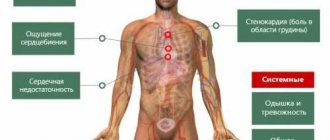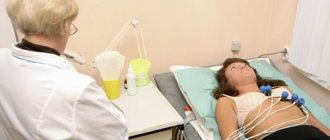Is it possible to do general anesthesia for tachycardia?
In itself, tachycardia is not an absolute contraindication to the use of this type of anesthesia during surgery. Before giving this type of anesthesia to a patient with tachycardia, the anesthesiologist will administer premedication to regulate the patient’s heart rhythm. In addition, before giving an anesthetic, the doctor will check the results of an electrocardiogram, ultrasound of the heart, and Holter monitoring. If there are no organic heart diseases, general anesthesia can be used. If the results of such studies are not in the patient’s record, the doctor will ask you to undergo them.
Tachycardia can also occur as a complication after general anesthesia. In this case, additional quinine medications are prescribed to normalize heart function.
Recovery period
Restoration of heart rate and brain function after anesthesia occurs independently. If local anesthesia was used, the recovery period takes no more than a week. With general anesthesia, it takes from several months to several years. To help the body recover, the following medications are prescribed:
- Improves cerebral circulation: Vinpocetine, glycine, etc.
- Supports the condition of the heart muscles: potassium magnesium.
- Supporting the condition of blood vessels: Ascorutin, etc.
- Calming: Persen, Novopassit, Valerian, etc.
The list of prescriptions depends on the person’s condition and the results of the examination. During the recovery period, the day should be balanced. Sudden movements, overexertion, and severe physical fatigue should be avoided. Daily walking helps a lot. To improve brain function, special exercises are used that stimulate brain activity.
The functioning of the brain directly depends on the functioning of the heart. If tachycardia, arrhythmia or other disruptions bother you for a long time, you should pay attention to this and undergo an examination. A specialist will help restore the body’s functioning and avoid consequences that require drastic measures of intervention.
Source: serdechnic.com
General anesthesia for bradycardia
Bradycardia is a slow heartbeat when the heart rate is less than 60 beats per minute. But anesthesia (narcosis) for bradycardia is contraindicated when the number of contractions is less than forty. Therefore, the patient needs to undergo ECG studies before surgery to determine the heart rate more accurately.
If the frequency is below normal, the cardiologist finds out the cause of the disease and prescribes treatment, after which, when the indicators stabilize, it is already possible to perform an operation with complete loss of consciousness.
Types of anesthesia
Anesthesia is characterized by an artificial, temporary and reversible shutdown of human consciousness. Anesthesia is used:
- for euthanasia of a person with complete loss of sensitivity and consciousness - general;
- for the absence of pain sensitivity in a specific organ - local.
Based on the principle of narcotic effects on the body, there are several types of anesthesia. Their operating principle and advantages are outlined in the table:
Read also: Glycine for tachycardia
The main requirement for anesthesia is individualization, i.e., for each patient, the drug and exposure time that suits the state of health are selected.
Mitral valve prolapse and anesthesia
The possibility of performing an operation under general anesthesia in a patient with a disease such as mitral valve prolapse is determined by a combination of various medical indicators. First of all, these are, of course, the results of an ECG and ECHO, which will show the degree of the disease; the doctor also looks at the general condition of the body and concomitant diseases. As a result, a decision is made for a specific patient.
For example, if a patient has first-degree mitral valve prolapse and no concomitant diseases, this issue is resolved positively.
Preparation for surgery under general anesthesia
To prepare for surgery, patients with cardiovascular pathology are prescribed an extensive examination. In addition to the ECG, echocardiography, cardiac ultrasound, and exercise tests are prescribed. For patients with extrasystole, cardiac arrhythmia, especially its atrial fibrillation form, as well as clinical manifestations of sinus bradycardia, 24-hour Holter monitoring is necessary. In addition, blood pressure is regularly measured and the full range of laboratory tests provided for in the standard scheme is carried out.
The decision to stop taking medications for maintenance therapy is made by the cardiologist together with the attending physician and anesthesiologist, usually done as follows:
- Nitrodrugs, adrenergic blockers and vasodilators, calcium channel blockers are taken until the day of surgery. Cardiac glycosides are discontinued several days before the procedure; to maintain the contractility of the heart, the anesthesiologist will inject special short-acting drugs intravenously;
- Indirect anticoagulants, which are usually taken by patients after valve replacement, stenting or coronary artery bypass surgery, are replaced 4-5 days before surgery with direct ones (heparin, fraxiparin are administered) to make it easier to manage hemostasis during surgery.
Direct acting anticoagulant drug
- Patients operated on for congenital and acquired heart valve defects and having endoprostheses can be operated on only after a prophylactic course of antibacterial therapy, this is necessary to prevent the development of infective endocarditis.
In the presence of cardiac arrhythmia, additional therapeutic measures are carried out:
- When cardiac arrhythmia is detected, it is important to determine its cause and take measures to eliminate it. It can be caused by ischemia of the myocardium, incorrect selection of drugs or their side effects. Ventricular extrasystole may be associated with a sudden cessation of smoking in patients with a long history of smoking.
- Atrial fibrillation is a relative contraindication to elective surgery. Surgical intervention is possible only in the normosystolic form, that is, when the contraction of the ventricles, despite the inadequate functioning of the atria, occurs in a “normal” mode. If the rhythm of atrial fibrillation cannot be restored with the use of antiarrhythmic drugs, a temporary pacemaker should be considered.
It is important to know: preparation for surgery for patients with diseases of the cardiovascular system includes examination by a cardiologist and correction of previously recommended prescriptions. Patients with atrial fibrillation are examined especially carefully.
Man consulting with a cardiologist
Physiological sinus bradycardia in trained individuals does not have a negative effect on the course of anesthesia; in the presence of clinical symptoms, this condition requires correction or installation of a pacemaker. In addition, additional drugs may be prescribed to correct the rhythm in atrial fibrillation and extrasystole, as well as to improve coronary circulation.
Anesthesia for high blood pressure
It is not an absolute contraindication. The anesthesiologist, depending on the duration and complexity of the operation, will assess all the risks and make a decision. As a rule, planned operations with complete loss of consciousness in case of high blood pressure are not performed. Before surgery, the patient returns his parameters to normal with the help of special therapy. If the operation is urgent, the specialist will constantly monitor blood pressure levels, using regulating medications at the slightest deviation from the norm.
High blood pressure can also manifest itself after anesthesia. In this case, the doctor will prescribe a course of treatment, and, most likely, will advise proper nutrition, giving up bad habits and exercise (if possible).
Indications and contraindications for surgery
For sinus tachycardia, surgery is performed if conservative treatment methods do not help. An important factor for resorting to surgical intervention is the frequency of attacks or tachycardia that increases over time in children. Surgery is recommended to avoid serious complications of the disease. The main indications include:
- ventricular fibrillation;
- resistance or intolerance to drugs;
- serious complications.
For AV nodal tachycardia, intervention is prescribed in many cases. In this case, the nodal pacemaker is affected, which leads to serious complications. Radical treatment is prescribed when:
- frequent relapses;
- severe tolerability of attacks;
- ineffectiveness of drugs;
- there are contraindications to long-term conservative treatment;
- pregnancy has occurred;
- the patient is young, which is necessary if the child’s adaptation to the social environment is impaired and developmental deviations are observed.
Paroxysmal arrhythmia is often a congenital mutation that changes the walls or ventricles of the heart. Often the disease is not life-threatening, but can cause great discomfort and subsequently lead to psychosomatic illnesses. Indications for surgical intervention are the same as for AV nodal arrhythmia.
Two types of operations are used: cardiac ablation under local anesthesia and implantation of a pacemaker. The same methods are used for surgical elimination of nodal, paroxysmal and sinus tachycardia.
Anesthesia after stroke
As for a stroke, the situation here is exactly the same as with a heart attack. A stroke suffered less than six months ago is an absolute contraindication to the use of this type of pain relief. However, as in the previous case, if the risk to the patient’s life is high enough, the operation will be performed with complete loss of consciousness.
The risk of stroke after general anesthesia exists in elderly patients, especially if brain damage has already occurred. Danger exists if the operation is urgent and long-term, if it is performed on the brain, neck, heart or carotid artery, and also if the patient has heart and lung diseases.
Increased heart rate after surgery
Hello! I am 31 years old. I had SVC syndrome. In the summer we had ether radiotherapy surgery. After this I often experience tachycardia. My normal blood pressure is upper 6. With tachycardia (130 beats), the pressure increases from 121 to 133. (For example: 2.0) such conditions last from several minutes to several hours.
) called an ambulance when the pulse was elevated, when the ambulance arrived (after 40 minutes or an hour), the pulse had already decreased on its own. My cardiac surgeon says that the operation went well and it cannot be SVC syndrome, that the heart gets used to it. Soon it will be 3 months since the operation was performed, it takes a while to get used to it. I attached the results of the cardiogram from the ambulance (they did it with an old cardiograph and the suction cups kept coming off) and the latest cardiogram from the hospital where the operation was performed.
Indeed, sinus tachycardia sometimes occurs after RFA surgery, no big deal. First of all, I would make sure that there is no anemia (it is worth doing a general blood test). However, most likely you are describing a manifestation of a neurotic disorder. Talk to a therapist about your symptoms.
Thank you very much! Before the operation, I took a general blood test. Everything was OK. I'll rent it again just in case. What causes neurotic disorders? I don’t seem to be nervous and at the moment of tachycardia I am calm, like a boa constrictor. How long can tachycardia last after surgery? Is it worth installing a halter? Thank you!
Neurotic disorders and not being nervous are slightly different things. Make a halter, of course. This is a completely harmless procedure. Sometimes it allows you to dispel some of the unfounded fears.
Consultation is provided for informational purposes only. Based on the results of the consultation received, please consult a doctor.
Forum about heart and vascular diseases
Hello! I am 31 years old. I had SVC syndrome. In the summer we had ether radiotherapy surgery. After this I often experience tachycardia. My normal upper pressure is 98 - 106. With tachycardia (130 beats), the pressure rises from 121 to 133. (For example: 128-86-112, 133-88-130) such states last from several minutes to several hours.
) called an ambulance when the pulse was elevated, when the ambulance arrived (after 40 minutes or an hour), the pulse had already decreased on its own. My cardiac surgeon says that the operation went well and it cannot be SVC syndrome, that the heart gets used to it. Soon it will be 3 months since the operation was performed, it takes a while to get used to it. I attached the results of the cardiogram from the ambulance (they did it with an old cardiograph and the suction cups kept coming off) and the latest cardiogram from the hospital where the operation was performed.
Effects of anesthesia on the cardiovascular system
According to statistics, people with pathologies of the cardiovascular system, for the most part, tolerate anesthesia positively. The choice of an anesthesiologist who can properly cope with his work plays a fundamental role.
The effect of anesthesia on the heart and blood vessels has long been considered by scientists: anesthesia is tolerated differently by people with individual physiological characteristics. For example, some patients feel satisfactory after surgery and awakening, while others recover from anesthesia within six months.
Depending on the type of arrhythmia, before the operation the doctor conducts all the necessary examinations and individually selects an anesthetic drug depending on the type of arrhythmia and the severity of the existing pathology.
After surgery, the components of the substance are eliminated from the body within 24 hours. It is then that they cease to have an effect on the myocardium. The risk of complications is most likely not from the anesthesia itself, but from difficulties during surgery.
Anesthesia and tachycardia
Surgical treatment is performed under anesthesia. It may contain up to 15 drugs that have a greater or lesser effect on blood pressure. The use of drugs containing narcotic analgesics in medicine has a strong effect on the central nervous system and also causes heart disease. Tachycardia and anesthesia, when combined, can cause a lot of unpleasant consequences, but the anesthesiologist must make efforts to prevent complications. There are no categorical contraindications for the use of anesthesia for tachycardia.
To one degree or another, anesthetics affect the functioning of the cardiovascular system and inhibit its functions. But thanks to the effect on compensatory mechanisms, the suppressive effect does not have dangerous side complications. But there is both tachycardia and a drop in blood pressure after general anesthesia.
Risks of using anesthesia for cardiovascular diseases
Any anesthesia affects the functioning of the heart and cardiovascular system as a whole. Depending on the type of heart disorder, doctors assign an index score to each risk group. By summing up these scores, doctors make a conclusion about which anesthesia drug to prescribe and what type of anesthesia to choose.
The risk group when using anesthesia includes the following pathologies of the cardiovascular system:
- the presence of an early or late post-infarction period;
- high or low blood pressure;
- coronary heart disease, angina pectoris;
- heart rhythm disturbances;
- some heart defects.
In addition to these risk groups, it is worth highlighting separately patients with concomitant chronic diseases, as well as the elderly. For example, for tachycardia, general anesthesia is allowed, but before the operation the doctor is obliged to collect all the data and adjust the patient’s heart rhythm. Tachycardia also often occurs as a complication after anesthesia.
For bradycardia, anesthesia is contraindicated only if the heart rate is less than 40 beats per minute. In this case, there is a huge risk of cardiac arrest and death. The doctor prescribes drug therapy, and after successful treatment, surgery is performed under anesthesia.
Low blood pressure is also not a contraindication, although it is included in the risk group. Indicators are perfectly regulated during surgery using infusion therapy and are monitored by a doctor throughout the entire procedure. High blood pressure during urgent operations can be controlled, and during planned interventions, therapy is prescribed to lower the levels.
If the patient suffered a heart attack less than six months ago, the decision on anesthesia will be negative, but for urgent interventions this type of anesthesia is allowed. The same situation applies to strokes.
How does anesthesia affect the heartbeat?
General anesthesia and all its components negatively affect the functioning of the cardiovascular system. The strength and level of impact depends on the drug used. The supply of anesthetic through a mask in gaseous form or through intravenous injection complicates the work of the myocardium. The speed at which a person falls into artificial sleep depends on the amount of anesthesia used. During complex operations, the drug is administered through a dropper. If a person already has pathologies before the procedure (especially asthma, arrhythmia), then the doctor is obliged to do a full examination and select the type of anesthesia individually.
Consequences of using artificial sleep:
- pain in the chest area;
- changes in heart rate;
- the chest begins to burn or pound;
- feeling of constriction in the heart.
If a person has kidney problems, then this type of pain relief is contraindicated for him.
Contraindications to the use of anesthesia include the following symptoms:
- dyspnea;
- impairment of kidney and liver function;
- allergy to anesthetic;
- heart failure.
Return to contents
Is general anesthesia allowed for tachycardia?
The anesthesiologist prepares the patient for artificial sleep. During the period before the procedure, doctors examine the patient, study diseases, and allergic reactions to medications. The following factors are especially carefully studied:
- pathologies of the heart and blood vessels;
- features of previous treatment regimens;
- the effectiveness of certain drugs;
- psychological characteristics of a person.
Return to contents
Risks before and after artificial sleep
General anesthesia during use may cause an attack of tachycardia. Reasons for increased heart rate include:
- breathing rhythm disturbances;
- lack of oxygen;
- bronchospasms.
In the postoperative period, a person may experience panic attacks.
In some patients with tachycardia in the postoperative period, the following consequences are possible:
- spasms;
- heartache;
- blood pressure surges;
- increased heart rate;
- attacks of panic and anxiety;
- dizziness;
- fainting.
To minimize complications after the introduction of general anesthesia, you need to regularly do a cardiogram to monitor the level of heartbeat and the proper functioning of blood vessels.
To relieve panic attacks, sedatives and work with a psychotherapist are prescribed. Recommended medications include the following medications, which are presented in the table:
Rules for the use of anesthesia for cardiac arrhythmia
If arrhythmia is diagnosed, the risk of administering anesthesia before surgery doubles. If surgery is urgent and urgent, the doctor is obliged to take all necessary measures: prepare the patient, collect data on his diagnosis, and assess the risk of complications.
After this, anesthesia is administered using certain drugs. After the operation is completed, the patient undergoes a rehabilitation period.
Preparatory stage
Before performing surgery, all the necessary tests are taken from a patient with arrhythmia and a number of studies are carried out:
- Electrocardiogram of the heart. Detection of pathological changes on the ECG directly affects the choice of drug. Atrial fibrillation is one of the most important indicators for this study, influencing the final decision of the anesthesiologist.
- Analysis for blood group and Rh factor. Data is required in case of unforeseen circumstances for donation.
- General and chemical blood test. During the study, the level of protein, bilirubin, cholesterol and other indicators is determined.
- Coagulogram. A blood clotting test will help avoid complications due to blood loss.
- Chest X-ray. The study allows us to exclude tuberculosis and the development of lung pathologies.
Preparing a patient with arrhythmia for surgery also includes completely quitting smoking and alcohol, undergoing a course of treatment for chronic diseases and normalizing weight.
In addition, premedication is carried out - drug preparation for the intervention.
Features of administering anesthesia for arrhythmia
Before administering the drug, the doctor must talk with the patient to find out if he has any contraindications to a particular anesthetic drug. During this conversation, as well as on the basis of the collected data, the anesthesiologist finally decides on the choice of drug and type of anesthesia.
The introduction goes like this:
- anesthesia is introduced into the patient’s body using a catheter, sometimes an inhalation mask is used instead;
- throughout the operation, anesthesia enters the bloodstream, providing the patient with sound sleep;
- in case of arrhythmia, the patient is given special medications before surgery to normalize heart function and stabilize blood pressure;
- Doctors carefully monitor all indicators of heart function during surgery.
Anesthesia drugs used for arrhythmia
Depending on the type of anesthesia, different drugs will be used:
- General anesthesia. When performing short-term operations on patients with arrhythmia, monoanesthesia is used, which involves the administration of one drug. Doctors often use Ketamine. Also for patients with arrhythmia, a 1% solution of Hexenal and sodium thiopental are used. To prevent bradycardia, atropine is additionally administered.
- Local anesthesia. During simple surgical interventions (for example, in dentistry), topical anesthesia is used with the administration of the drugs “Lidocaine” and “Kamistad”. In maxillofacial surgery, Novocain is used, and when administering local anesthesia, Trimecain is often used. During childbirth, as well as operations on the legs or spine, epidural and spinal anesthesia are used. In this case, the drugs Mepivacaine and Ropivacaine are used.
Rehabilitation period
To prevent the effects of anesthesia, if unpleasant symptoms appear after surgery (dizziness, a feeling of heaviness in the heart), you should immediately consult a doctor. Only an intraanesthesia complication can affect the functioning of the heart: disruption of the rhythm of breathing and blood supply during the operation.
During the rehabilitation period, you should adhere to the following rules:
- normalization of sleep patterns;
- sufficient rest;
- walks in the open air;
- healthy eating.
Anesthesia for arrhythmia is not contraindicated, but requires special attention from the anesthesiologist in selecting the drug, taking into account the type and severity of the pathology. By following the recommendations of doctors, you can significantly prevent complications after using anesthesia with a history of arrhythmia.
Methods of performing heart surgery for tachycardia
Anonymous, Female, One year
Of course, the complete loss of consciousness caused by the use of anesthetics, one way or another, affects the body. If a person is completely healthy, then most likely he has nothing to fear, and the use of anesthetics will not have any consequences. But is there any reason to worry for people with heart disease? In this article we will discuss whether general anesthesia is possible for various heart diseases.
Elimination of the pathological focus is carried out without general anesthesia. Through a small puncture of the skin, a catheter is inserted through a vein up to the heart chamber with the source of the disease. The actions are monitored through an X-ray machine. After identifying the affected area, cauterization is performed with high-frequency current.
Implantation of an artificial pacemaker for tachycardia involves attaching a small device (pacemaker). The device is placed in the heart and carried out using a catheter through the lateral vein of the arm. Such devices prevent attacks; when an arrhythmia begins, an electrical impulse is emitted that suppresses the attack. When a pacemaker is installed, the patient should visit the doctor frequently to ensure that the pacemaker is working properly.
Open surgery
The intervention is performed under general anesthesia and when the patient undergoing surgery is transferred to artificial circulation. Open heart surgery is performed with cutting and removal of damaged arrhythmic areas. This makes it possible to stop tachyarrhythmic attacks for a long time, provided that the doctor’s recommendations given to the patient are followed.
Copying site materials is possible without prior approval if you install an active indexed link to our site.
The information on the site is provided for general information purposes only. We recommend that you consult your doctor for further advice and treatment.
Despite the fact that modern surgery has made a huge step in its development in recent years, there are often cases of complications arising from heart surgery. The most common of them is paroxysmal supraventricular tachycardia. How tachycardia is treated after heart surgery, you will find out below.
It is characterized by a sharp increase in heart rate, while maintaining the correct rhythm. Before we answer the above question, we want to remind you that medications for cardiac tachycardia. prohibited for use without prior consultation with a specialist.
Paroxysmal tachycardia is formed due to the fact that the damaged source of rhythm is located in the atria. The disease is paroxysmal, with attacks characterized by suddenness. Often patients notice a sharp shock in the chest area, which turns into tachycardia.
Often, before an attack of illness, so-called precursors make themselves felt. These include discomfort in the chest area, tinnitus, and dizziness. According to doctors, paroxysmal supraventricular tachycardia after cardiac surgery is observed in patients undergoing rehabilitation.
A severe attack of tachycardia may be accompanied by an increase in heart rate up to 200 beats per minute. In children, this mark can reach 300 beats per minute. An attack episode can last from half an hour to several days. It all depends on the severity of its manifestation.
During an attack, the patient’s condition may be completely normal, but in certain cases attacks are accompanied by suffocation, trembling in the fingers, and blurred vision. Very often phenomena arise that indicate disturbances in the vegetative functions of the body. This is sweating and increased intestinal motility. An attack may also result in involuntary urination.
An attack of the disease, which is protracted, directly threatens a person’s life, since a very large number of heart contractions are ineffective. There is a sharp decrease in cardiac output, for this reason the development of heart failure. This, in turn, leads to a lack of oxygen inside the body, which can lead to hypoxia of the brain and directly the heart muscle. Often this causes death.
Most often, tachycardia develops in the early postoperative period. At this stage, the patient is usually under constant medical supervision, so the complication is diagnosed in time and can be eliminated with medication. If you notice signs of illness after leaving the hospital, you should urgently seek advice from your treating cardiologist.
The current level of development of cardiovascular surgery and extensive operational experience make it possible to predict the risk of surgery depending on the patient’s initial condition, nosological form of the disease, concomitant pathology and other factors.
As a result of a generalization of long-term observations in various cardiac surgery centers of the European Association of Thoracic and Cardiovascular Surgeons, in 1998 a system for assessing the risk of heart surgery, EuroSCORE, was proposed.
The risk of surgery is calculated based on scoring. The expected mortality rate with a score of 0 to 2 (low risk) is 1.27 - 1.29%; from 3 to 5 (average risk) - 2.90 - 2.94%; over 6 (high risk) - 10.54%.
One type of cardiac arrhythmia is tachycardia, which usually occurs due to accelerated conduction of contraction impulses. To eliminate the problem of rapid heartbeat, a modern technique is used - radiofrequency ablation (RFA).
This technique is otherwise called “cauterization,” because a small area of the myocardium that provokes pathological contractions is stopped (“cauterized”) using radiofrequency signals. The result is that the main pathways of impulses remain in a normal state, and additional, ectopic sources are eliminated, and the heart rate returns to normal.
Before the operation, the patient is taken to an anesthesiologist, who examines him and identifies contraindications to anesthesia. In this case, anesthesia can be combined. This means that the patient is sedated intravenously (general anesthesia) and into the skin where the radiofrequency cautery catheter is inserted (local anesthesia). General anesthesia is usually administered through the femoral artery or vein in the groin area.
After the effect of anesthesia, a conductor is introduced to the patient - an introducer. A probe with a sensor at the end is guided along it. To ensure that the probe reaches the desired area of the heart, X-ray monitoring is carried out at each stage of the operation. In this case, the region of the heart is selected depending on the location of the source of extraordinary contractions.
Once access to the heart is established, the exact location of the source of additional nerve impulses is determined. It is possible to examine the heart muscle with high accuracy only with intravascular electrophysiological study (EPS).
EPI is carried out by introducing the device through previously installed introducers. The essence of the study is to apply physiological current discharges and stimulate the heart muscle with a special device. If, during stimulation, the heart muscle responds to the sent impulses in a standard manner, rapid heartbeat does not occur, it is considered that this area is functioning normally.
Thus, with the help of an electrode, the remaining areas are stimulated until areas with pathology are detected. When the area responsible for the rhythm disturbance is found, it is cauterized. Because locating this area or areas takes a long time, the operation can vary from 1.5 to 6 hours.
After RFA, when cauterization of the heart for arrhythmia is performed, the doctor diagnoses the patient’s condition within minutes based on ECG readings. If the heart muscle functions in a normal rhythm, the catheter is removed. A pressure bandage is applied to the introducer site.
Important! After RFA, the patient must strictly adhere to bed rest for 24 hours. After a few days he may be discharged from the hospital, but even after this the patient must be under the supervision of a specialist.
When arrhythmia occurs, myocardial function is impaired. The heart loses the ability to perform its usual work as usual. The most common form of the disorder is atrial fibrillation. In the absence of positive dynamics from drug treatment, the doctor offers the patient alternative options. Cauterization of the heart for arrhythmia is considered the most effective. Some refuse the procedure due to insufficient understanding of it.
Consequences of anesthesia and anesthesia during and after surgery
Currently, there are no medical procedures that do not have complications. Despite the fact that modern anesthesiology uses selective and safe drugs, and anesthesia techniques are improved every year, there are complications after anesthesia.
There may be unpleasant consequences after anesthesia
When preparing for a planned operation or suddenly faced with its inevitability, every person feels anxiety not only about the surgical intervention itself, but even more because of the side effects of general anesthesia.
The choice of anesthesia depending on the type of operation
Endotracheal anesthesia
Surgeries on the respiratory organs, heart and blood vessels are performed exclusively under general endotracheal anesthesia, since this is the only method of pain relief that can provide adequate analgesia and maintenance of vital functions during such interventions. Open abdominal surgeries are also performed under general anesthesia, since it is impossible to provide a good level of pain relief and muscle relaxation for a long period using a spinal or epidural block without the risk of additional complications.
When performing laparoscopic operations, interventions on the pelvic organs, perineum, rectum, lower extremities, the choice of anesthesia is carried out taking into account the volume of the operation and the type of concomitant cardiac pathology. In preparation for a planned operation, the patient should be examined by an anesthesiologist in advance.
Complications of anesthesia
Adverse events of this procedure can be divided into two groups (according to the time of their occurrence):
- Occur during the procedure.
- They develop at different times after the operation is completed.
During the operation:
- From the respiratory system: sudden cessation of breathing, bronchospasm, laryngospasm, pathological restoration of spontaneous breathing, pulmonary edema, cessation of breathing after its restoration.
- From the cardiovascular system: increased heart rate (tachycardia), slowdown (bradycardia) and disturbance (arrhythmia). Fall in blood pressure.
- From the nervous system: convulsions, hyperthermia (increase in body temperature), hypothermia (decrease in body temperature), vomiting, tremor (shivering), hypoxia and cerebral edema.
During the operation, the patient is constantly monitored to avoid complications.
All complications during the procedure are monitored by an anesthesiologist and have strict algorithms for medical actions aimed at stopping them. The doctor has medications on hand to treat possible complications.
Many patients describe visions during anesthesia - hallucinations. Hallucinations make patients worry about their own mental health. There is no need to worry, since hallucinations are caused by some narcotic drugs used for general anesthesia. Hallucinations during anesthesia occur in mentally healthy people and do not recur after the drug wears off.
After the operation is completed
After general anesthesia, a number of complications develop, some of which require long-term treatment:
- From the respiratory system.
Often appear after anesthesia: laryngitis, pharyngitis, bronchitis. These are the consequences of the mechanical impact of the equipment used and the inhalation of concentrated gaseous drugs. Manifested by cough, hoarseness, pain when swallowing. They usually go away within a week without consequences for the patient.
Pneumonia. A complication is possible when gastric contents enter the respiratory tract (aspiration) during vomiting. Treatment will require additional hospital stay after surgery and the use of antibacterial drugs.
- From the nervous system.
Central hyperthermia is an increase in body temperature not associated with infection. This phenomenon may be a consequence of the body’s reaction to the administration of drugs that reduce the secretion of sweat glands, which are administered to the patient before surgery. The patient's condition returns to normal within one to two days after their action ceases.
Elevated body temperature is a common consequence of anesthesia
Headaches after anesthesia are a consequence of the side effects of drugs for central anesthesia, as well as complications during anesthesia (prolonged hypoxia and cerebral edema). Their duration can reach several months, they pass on their own.
Encephalopathy (impaired cognitive function of the brain). There are two reasons for its development: it is a consequence of the toxic effect of narcotic drugs and a prolonged hypoxic state of the brain as a result of complications of anesthesia. Despite the widespread belief about the frequency of development of encephalopathy, neurologists argue that it develops rarely and only in individuals with risk factors (background brain diseases, old age, previous chronic exposure to alcohol and/or drugs). Encephalopathy is a reversible phenomenon, but requires a long recovery period.
To speed up the process of restoring brain function, doctors suggest carrying out prophylaxis before the planned procedure. To prevent encephalopathy, vascular drugs are prescribed. They are selected by the doctor, taking into account the characteristics of the patient and the planned operation. You should not carry out independent prevention of encephalopathy, since many drugs can change blood clotting and also affect susceptibility to anesthesia.
Peripheral neuropathy of the extremities. It develops as a consequence of the patient being in a forced position for a long time. It manifests itself after anesthesia as paresis of the muscles of the limbs. It takes a long time and requires physical therapy and physiotherapy.
The effect of anesthesia on the body
Interference with the body's functioning has certain consequences. They can be minimized, but cannot be completely avoided. Possible reactions after anesthesia:
- swelling of the respiratory system causing blockage of oxygen;
- the body's response to a disorientated state in the form of nausea, vomiting, may occur unconsciously during anesthesia;
- changes in heart rhythm due to surges in blood flow pressure;
- cerebral circulatory disorders, swelling;
- changes in breathing rhythm as a result of inflammation of the respiratory tract;
- CNS disorder.
With local anesthesia, a rapid heartbeat also occurs and goes away when the substance is removed from the body. This usually takes from several hours to a day. In this case, rest is required to avoid pressure surges.
Particular attention should be paid to the child's condition. If his heart beats strongly after anesthesia, his level of concentration is reduced, and memory lapses are observed, this means that the functioning of the main organs: the brain and heart is impaired. This condition requires medical intervention. If measures are not taken in time, hyperactivity develops, the child begins to walk on his toes, memory and speed of thinking decrease. The most dangerous period of exposure to anesthesia is before the age of two, since during this period neural connections are just developing. The consequences are clearly visible during the learning period; the child has no desire to learn, since the assimilation of information is associated with significant difficulties in perception.
In adults, the effects of anesthesia are less pronounced. In a healthy person they pass quickly. If any serious pathology of the central nervous system, brain or heart develops in the body, the following consequences are observed:
- insomnia, prolonged sleep;
- rapid heartbeat after anesthesia for 3-4 months;
- loss of strength, rapid fatigue;
- depression, sudden mood swings;
- absent-mindedness, interruption of the chronology of events;
- short period of concentration, difficulty in perceiving information.
Particular attention to your condition after anesthesia should be paid to women who used local or general anesthesia during childbirth. Repeated use of anesthesia throughout life contributes to the development of cardiac pathologies.
The likelihood of a situation where the heart beats strongly after anesthesia increases arithmetically with existing disorders and diseases of the cardiovascular system. Anesthesia is a stress factor that does not change the functioning of the heart on its own, but becomes an impetus for the development of existing diseases. 70% of complaints about palpitations in the subsequent period arise due to exacerbations, and not newly developing abnormalities. This fact cannot be ignored, since a mild form of pathology over the years passes into a stage when the situation can only be corrected through surgery.
Complications of local anesthesia
Spinal and epidural anesthesia
Spinal and epidural anesthesia replaces anesthesia. These types of anesthesia are completely devoid of side effects of anesthesia, but their implementation has its own complications and consequences:
The patient often experiences a headache after anesthesia.
- Headache and dizziness. A common side effect that appears in the first days after surgery and ends with recovery. Rarely, headaches are persistent and continue for a long time after surgery. But as a rule, such a psychosomatic condition, that is, is caused by the patient’s suspiciousness.
- Paresthesia (tingling, crawling sensation on the skin of the lower extremities) and loss of sensitivity in areas of the skin of the legs and torso. It does not require treatment and goes away on its own within a few days.
- Constipation. Often occur during the first three days after surgery as a consequence of anesthesia of the nerve fibers innervating the intestines. Once nerve sensitivity is restored, function is restored. In the first days, taking mild laxatives and folk remedies helps.
- Neuralgia of the spinal nerves. Consequence of nerve injury during puncture. A characteristic manifestation is pain in the innervated area that persists for several months. Physical therapy and physiotherapy help speed up the process of its recovery.
- Hematoma (bleeding) at the puncture site . Accompanied by pain in the damaged area, headaches and dizziness. When the hematoma resolves, there is an increase in body temperature. As a rule, the condition ends in recovery.
Brainstem and infiltration anesthesia
- Hematomas (bleedings). They occur as a result of damage to small vessels in the anesthesia zone. Manifested by bruising and pain. They go away on their own within a week.
- Neuritis (nerve inflammation). Pain along the nerve fiber, sensory disturbance, paresthesia. You should consult a neurologist.
- Abscesses (suppuration). Their occurrence requires additional treatment with antibiotics, most likely in a hospital setting.
A complication of any type of anesthesia, from superficial to general anesthesia, can be the development of allergic reactions. Allergies vary in severity, from hyperemia and rash to the development of anaphylactic shock. These types of side effects can happen to any medicine and food. They cannot be predicted if the patient has not previously used the medicine.
When going for an operation, it is worth remembering that the qualifications of anesthesiologists will allow you to cope with any complex and unforeseen situations. The hospital has the necessary equipment and medications to maintain the patient’s health. Cases of death and disability from pain management are rare in world practice.
Tachycardia
Total messages: 28 Registered: June 22, 15:39 User rating: 0
September 26, 18:05#1
My sister had an operation to remove an ASD in July, now she is still on sick leave, the doctor scares us because her pulse is very high. Has anyone encountered such a problem? She was prescribed Concor; she is afraid to drink it, they say it will last her life. P
Total messages: 83 Registered: Mar 7, 13:39 From: St. Petersburg User rating: 0
September 26, 18:20#2
Tatiana! I have the same problem! They said that in six months everything would be normal, but for me it only got worse. I recently went to Bakuleva about this, they stopped my old pills and prescribed new ones, and they also told me to do something to understand the reasons, now I’m going to the doctors again. What treatment were you prescribed for tachycardia? What is your resting pulse without pills (mine is 96-100).
Total messages: 83 Registered: Mar 7, 13:39 From: St. Petersburg User rating: 0
September 26, 18:21#3
And Concor was canceled for me, the arrhythmologist said that Concor only aggravates the situation, like maybe because of it my tachycardia does not go away.
Total messages: 83 Registered: Mar 7, 13:39 From: St. Petersburg User rating: 0
September 26, 18:35#4
The biggest problem with Concor is this. It was prescribed to me back in December 2010. First 1/4 of 2.5 mg. Before the operation I drank this way. In the hospital after the operation, they confirmed this dose to me and told me to drink until my pulse returns to normal. The result from Concor was so-so, the pulse was 75, but more often 80-90. Moreover, after physical exercise, he himself did not calm down (as it should be within 20 minutes to return to normal). In general, the dose was increased 2 times (1.25 mg). At first the effect was good, but gradually began to decline - again it returned to the same 80-90. Again (in July) they increased it 2 times (to 2.5 mg). And then a new problem appeared - the pressure was 80/50 in the morning. They divided it into 2 doses, but to no avail. The cardiologist says - be patient, you need to reduce your pulse, it’s not so important. I endured it for 1.5 months, after which I went to Bakuleva for a consultation. It was there that they told me that Concor should not be taken under any circumstances, they said that the causes of tachycardia could be not only in cardiology, and they told me what to do. Have you seen anyone else besides the cardiologist? I mean, first of all, the endocrinologist and neurologist - very often the legs of tachycardia grow from there.
Read also: Tachycardia symptoms and treatment medications
Total messages: 28 Registered: June 22, 15:39 User rating: 0
After general anesthesia
After general anesthesia, absolutely everyone feels bad, although no ethers are used now.
It is well known that after their use, the liver stopped working in many patients.
Is general anesthesia harmful or is it a myth? Does anesthesia affect human life expectancy and health?
Modern anesthesia drugs have little toxicity to human organs.
If the dose is calculated correctly for you, the drug is administered correctly, there is nothing to be afraid of.
But we are afraid of anesthesia and pain, although we understand the inevitability of the operation and its necessity.
Now there is a lot of new things: equipment, drugs, a lot of new technologies, but we are still afraid, perhaps we don’t know what anesthesia is? What to expect from him?
Anesthesia implies safety during and after surgery.
Surgery for paroxysmal tachycardia is not so scary
Since I was 28 years old I have had paroxysmal tachycardia. Now I am over 50. They suggested surgery - radiofrequency ablation. What kind of operation is this, how is it done, in what cases, and what could be the consequences? I ask a specialist to answer. After all, such a disease is not uncommon!
You are right, recently many readers have asked questions about heart rhythm disturbances. So let's first figure out how a healthy heart should contract.
Let us remember that the heart has 4 chambers: 2 atria and 2 ventricles. In healthy people, they contract rhythmically, that is, regularly and at equal intervals. Resting heart rate is 60 to 90 beats per minute. And with physical or emotional stress, the number of beats per minute may increase. Arrhythmia is a condition in which one or both of the main characteristics of a normal rhythm—regularity and frequency—are disrupted. How do such violations manifest themselves and why are they dangerous?
Read also: Tachycardia with hyperthyroidism
The most typical manifestations are sensations of interruptions in the functioning of the heart. For example, pauses between contractions or extraordinary contractions. There are attacks (paroxysms) of rapid heartbeat that occur suddenly. Sometimes you can understand their cause: fear or excitement, physical activity or elevated body temperature. But most often such attacks occur at rest. Paroxysm can last from several minutes to several hours and even days. A prolonged attack is dangerous. Especially if it is accompanied by fainting, dizziness or a feeling of clouding of consciousness. The longer the paroxysm, the faster complications arise, because there is an excessive load on the heart muscle. If this happens to you, you should urgently consult a doctor and get examined! The doctor will prescribe medicine.
If the attacks do not stop, their frequency and duration increase, then minimally invasive methods are used to eliminate their causes. This is not open heart surgery, but rather treatment using electrical impulses, cold (cryoablation), laser or radiofrequency. In such cases, catheters are used - diagnostic and therapeutic. They are usually administered through the femoral or subclavian vein. Using a diagnostic catheter and a computer, an accurate diagnosis of the tachycardia zone is carried out. Then, using a therapeutic catheter, this area is affected.
Radiofrequency ablation, which the doctor suggested to you, is used for atrial fibrillation or fibrillation, supraventricular tachycardia, as well as some types of ventricular tachycardia. There are also relative contraindications: chronic renal or heart failure; allergy to contrast agents used in this method and iodine intolerance; uncontrolled blood pressure; anemia and severe bleeding disorders (coagulopathy). Acute infections, fever, pulmonary edema, and excess medications are also considered contraindications.
The word “ablation” can be intimidating because it means “removal” in Latin. But in such cases, doctors do not remove anything, but cauterize it. What exactly? Let us remember: the heart must have a measured rhythm, which is supported by its own electrical conduction system. The system includes an electrical impulse generator (the main pacemaker) and conductive pathways connecting the entire electrical chain. But suddenly a new source of electrical impulse appears in the heart muscle, which knocks the heart out of its natural rhythm. This is a tiny area in the muscle that is burned during surgery. Then many patients no longer have to treat the arrhythmia. There is practically no pain, and recovery is fast. There are no stitches and no scars remain. After 2-3 days the patient is already discharged.
The same method is used to install an artificial pacemaker for bradycardia. In addition to cardiac surgery, ablation is also used in gynecology, oncology, and otolaryngology. So, if you have no contraindications, there is nothing to be afraid of.
Naturotherapist G.G. Garkusha
What is aortic stenosis?
Aortic stenosis is a narrowing of the aorta, the largest artery that connects to the left ventricle of the heart, through which oxygenated blood flows to supply the body with oxygen and nutrients. The most common cause of aortic stenosis is congenital—the defect is already present at birth. However, rheumatic fever can also cause aortic stenosis, and aging is associated with. ⇒
How to keep your heart healthy?
Although health ministers are trying to convince us that in a few years we will forget about cardiovascular diseases, this is hard to believe. Why? Yes, because half of the country's population has cholesterol levels that exceed normal levels - these are middle-aged people. And for those who are in favor. ⇒
Antihypertensive and antiarrhythmic drugs in the treatment of cardiovascular diseases
Those drugs that affect the blood itself, the blood vessels and heart muscle, can also be used to treat cardiovascular diseases. These drugs change heart rate and blood pressure, the pumping function of the heart, and blood clotting and flow. Antihypertensive drugs and medications Antihypertensive drugs are used to treat high blood pressure. (hypertension). Their. ⇒
The patient’s condition after general anesthesia, quality in a good clinic:
- No pain during treatment.
- No nausea or vomiting after surgery.
- Absence of chills, trembling (sometimes it is impossible to do without these symptoms after surgery).
- During operations, constant monitoring of breathing and blood circulation is carried out.
- Monitoring of electrical activity of the brain, control of muscle conduction, temperature control.
After the operation, the patient is given anesthesia; if this is not enough, the patients inject themselves by pressing a button.
For this purpose, special devices have appeared that the patient carries with him constantly.
Doctors then monitor how many times the patient presses the button, using these calculations to determine the degree of recovery of the patient.
Thanks to this, the time after surgery passes comfortably.
Before taking general anesthesia, consider:
- Your weight or body mass index.
- Medical history, tests, permission from specialists for anesthesia are studied.
- Patient's age.
- Current medications taken and allergic reactions to them.
- The patient's consumption of alcohol or drugs.
- Dental examination, as well as the oral cavity and respiratory tract.
General anesthesia, what is it:
General anesthesia, a state of coma, sleep in which the patient does not feel pain. He is not in pain, there are no reactions. The man seems unconscious.
General anesthesia is administered intravenously or inhaled.
Medicines are administered by an anesthesiologist, a specialist who monitors the patient's vital signs and breathing during surgery.
There are four stages:
Induction or first stage:
Characterized by the onset of drug administration and loss of sensitivity (consciousness).
Excitation stage – second stage:
There is delusional, excited activity. Heartbeats and breathing are erratic.
Nausea and dilated pupils may occur.
There is a danger of suffocation. Modern drugs limit the time for the two stages described above.
Surgical anesthesia or third stage:
When it occurs, all muscles relax and breathing is suppressed. Eye movement slows and then stops. The patient is ready for surgery.
Overdose stage, if your anesthesia dose was calculated incorrectly:
Leads to cardiovascular and respiratory failure.
As you understand, the fourth stage is an exception to the rule, but it sometimes happens, as everywhere and always.
Why do they do general anesthesia, and not anesthesia of only the necessary area of the body?
Under what circumstances is it prescribed?
- The operation takes a long time.
- Risk of major blood loss.
- According to the patient's well-being.
Modern surgical treatment is an absolutely safe intervention.
What is anesthesia?
Anesthesia or narcosis is a medical method of blocking the centers of the brain responsible for pain.
With the help of special blocker drugs, an effect occurs on nerve receptors, as a result of which a person is rendered unconscious or sensitivity in a certain area is blocked for a planned period of time. With general anesthesia, the goal is to immobilize the patient to avoid accidents during complex procedures. Time and dosage are strictly calculated, since uncontrolled use leads to irreversible changes in the brain, coma or death. Drugs can be delivered to the body intravenously, topically, or through the respiratory system using a mask.
There are cases when the individual characteristics of the body’s recovery are higher than calculated, the patient can wake up right on the operating table. This is not critical, the person does not experience pain and is quickly put back into anesthesia. Such cases occur in 1% of 100%. The use of anesthesia carries with it a number of risks that can lead to death. These are allergic reactions, inadequate response of organs to exposure, overdose. However, such risks are minimal. The possibility of death is 3 times less than death in an airplane or car accident.
Immediately after anesthesia you may feel:
- Difficulty passing urine.
- Bruising, pain on the arm due to the IV during surgery.
- Constant nausea, possible vomiting.
- Trembling and feeling cold, you will shake, and at first it will be difficult to warm up.
- Sore throat (due to the presence of a breathing tube during surgery).
- You will not feel pain; nurses will constantly administer pain relief.
But there are groups at greater risk for consequences:
Elderly people undergoing long-term operations are at risk of serious consequences.
After anesthesia, they can suffer a heart attack, amnesia (memory loss), stroke and even pneumonia.
Of course, it’s good that now you can have surgery and recover, if not for the consequences after it. They are.
The consequences are early and appear later.











